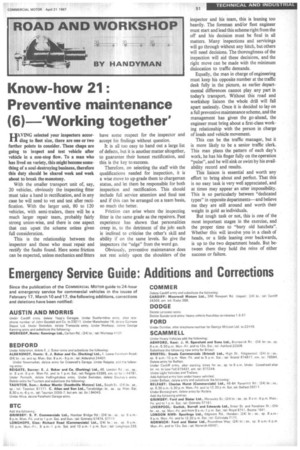Know-how 21: Preventive maintenance (6) 'Working together'
Page 53

If you've noticed an error in this article please click here to report it so we can fix it.
HAVING selected your inspectors according to fleet size, there are one or two further points to consider. These chaps are going to inspect and test vehicle after vehicle in a non-stop flow. To a man who has lived on variety, this might become something of a soul-destroying business, therefore this duty should be shared week and week about to break the monotony.
With the smaller transport unit of, say, 20 vehicles, obviously the inspecting fitter must take a hand in rectification, and in any case he will need to vet and test after rectification. With the larger unit, 80 to 120 vehicles, with semi-trailers, there will be a much larger repair team, probably fairly strong union-wise, and there is one aspect that can upset the scheme unless given full consideration.
This is the relationship between the inspector and those who must repair and rectify the faults found. Here some friction can be expected, unless mechanics and fitters have some respect for the inspector and accept his findings without question.
It is all too easy to hand out a large list of defects, but it is another matter altogether, to guarantee their honest rectification, and this is the key to success.
Therefore, on selecting the staff with the qualifications needed for inspection, it is a wise move to up-grade them to chargeman status, and let them be responsible for both inspection and rectification. This should include full service attention and final test and if this can be arranged on a team basis, so much the better.
Friction can arise where the inspecting fitter is the same grade as the repairers. Past experience has shown that personalities creep in, to the detriment of the job: each is inclined to criticise the other's skill and ability if on the same levels. So give the inspectors the "edge" from the word go.
Obviously, preventive maintenance does not rest solely upon the shoulders of the inspector and his team, this is leaning too heavily. The foreman and/or fleet engineer must start and lead this scheme right from the off and his decision must be final in all matters. Many inspections and servicings will go through without any hitch, but others will need decisions. The thoroughness of the inspection will aid these decisions, and the right move can be made with the minimum dislocation to traffic demands.
Equally, the man in charge of engineering must keep his opposite number at the traffic desk fully in the picture, as earlier departmental differences cannot play any part in today's transport. Without this road and workshop liaison the whole drill will fall apart uselessly. Once it is decided to lay on a full preventive maintenance scheme, and the management has given the go-ahead, the engineer must bring about a first-class working relationship with the person in charge of loads and vehicle movement.
This can be the traffic manager, but it is more likely to be a senior traffic clerk. This man plans the pattern of each day's work, he has his finger fully on the operation "pulse", and he will sink or swim by his availability record and results.
This liaison is essential and worth any effort to bring about and perfect. That this is no easy task is very well appreciated, and at times may appear an utter impossibility. This is so particularly between "dedicated types" in opposite departments—and believe me they are still around and worth their weight in gold as individuals.
But tough task or not, this is one of the most important stages in the exercise, and the proper time to "bury old hatchets". Whether this will involve you in a clash of heads, or a little leaning over backwards, is up to the two department heads. But between them they hold the reins of either success or failure.




































































































































